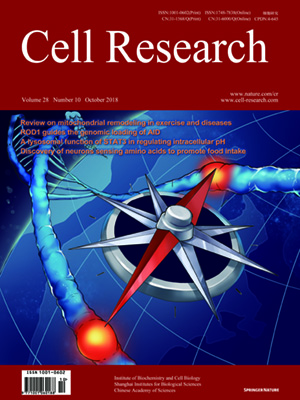
Volume 28, No 10, Oct 2018
ISSN: 1001-0602
EISSN: 1748-7838 2018
impact factor 17.848*
(Clarivate Analytics, 2019)
Volume 28 Issue 10, October 2018: 1013-1025 | Open Access
ORIGINAL ARTICLES
A post-ingestive amino acid sensor promotes food consumption in Drosophila
Zhe Yang 1,2, Rui Huang 3,4, Xin Fu 5,6,7, Gaohang Wang 1,2, Wei Qi 1,2, Decai Mao 8, Zhaomei Shi 5, Wei L. Shen 5 and Liming Wang 1,2
1Life Sciences Institute, Zhejiang University, Hangzhou 310058 Zhejiang, China; 2Innovation Center for Cell Signaling Network, Zhejiang University, Hangzhou 310058 Zhejiang,China; 3Key Laboratory for Biorheological Science and Technology of Ministry of Education, State and Local Joint Engineering Laboratory for Vascular Implants, Bioengineering College, Chongqing University, Chongqing 400030, China; 4Medical School, Chongqing University 400030, China; 5School of Life Science and Technology, ShanghaiTech University, Shanghai 201210, China; 6Institute of Neuroscience, Shanghai Institutes for Biological Sciences, Chinese Academy of Sciences, Shanghai 200031, China; 7University of Chinese Academy of Sciences, Beijing 100049, China and 8Gene Regulatory Laboratory, School of Medicine, Tsinghua University, Beijing 100084, China
Correspondence: Correspondence: Wei L. Shen (shenwei@shanghaitech.edu.cn) or Liming Wang (lmwang83@zju.edu.cn)These authors contribute equally: Zhe Yang, Rui Huang, Xin Fu.
Adequate protein intake is crucial for the survival and well-being of animals. How animals assess prospective protein sources and ensure dietary amino acid intake plays a critical role in protein homeostasis. By using a quantitative feeding assay, we show that three amino acids, L-glutamate (L-Glu), L-alanine (L-Ala) and L-aspartate (L-Asp), but not their D-enantiomers or the other 17 natural L-amino acids combined, rapidly promote food consumption in the fruit fly Drosophila melanogaster. This feeding-promoting effect of dietary amino acids is independent of mating experience and internal nutritional status. In vivo and ex vivo calcium imagings show that six brain neurons expressing diuretic hormone 44 (DH44) can be rapidly and directly activated by these amino acids, suggesting that these neurons are an amino acid sensor. Genetic inactivation of DH44+ neurons abolishes the increase in food consumption induced by dietary amino acids, whereas genetic activation of these neurons is sufficient to promote feeding, suggesting that DH44+ neurons mediate the effect of dietary amino acids to promote food consumption. Single-cell transcriptome analysis and immunostaining reveal that a putative amino acid transporter, CG13248, is enriched in DH44+ neurons. Knocking down CG13248 expression in DH44+ neurons blocks the increase in food consumption and eliminates calcium responses induced by dietary amino acids. Therefore, these data identify DH44+ neuron as a key sensor to detect amino acids and to enhance food intake via a putative transporter CG13248. These results shed critical light on the regulation of protein homeostasis at organismal levels by the nervous system.
https://doi.org/10.1038/s41422-018-0084-9
FULL TEXT | PDF
Browse 1926


